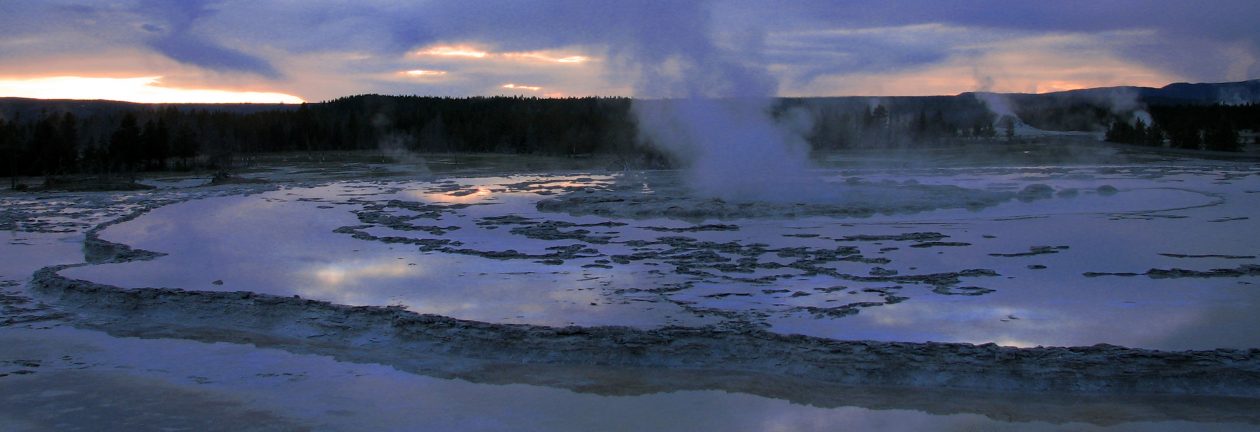Kathmandu, Nepal
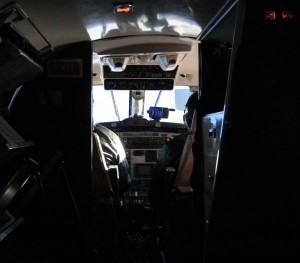
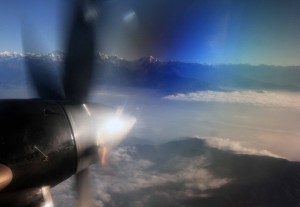


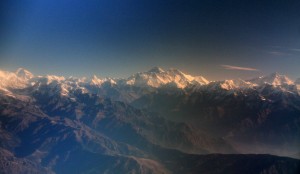
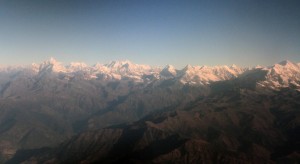
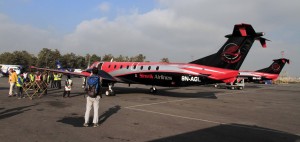
I woke up at 04:00 today, got ready, went downstairs to the hostel reception, waited for my taxi transportation to the airport, and at 05:00 I was led outside by one of the hostel staff members to a taxi waiting for me. I was then driven to the domestic terminal at the airport, where I waited outside with other airline passengers until the doors were opened at 05:30. When the doors opened, I passed through a security checkpoint, checked in for my mountain flight (scheduled to take off at 06:30), passed through another security checkpoint, and then sat down in the waiting area. Due to cloud coverage, the mountain flights were delayed (I think there were four scheduled flights in total) and I did not pass through the gate until 07:30. Then a bus took myself and another fifteen passengers to our designated plane, we boarded, and took off, breaking through the cloud coverage over Kathmandu, to see the Himalayan mountain range from above. Being first to check in at the airport terminal, I had the first window seat on the left-hand side of the plane – with the propeller in full view, obscuring a good bit of my scenery (I suspect the last seats may have been the best, but even they would’ve had the wing and engine blocking their forward view (Mount Everest was mostly in front of our plane, on the left-hand side), although looking directly out of the window from the back rows would’ve been unobstructed . . . perhaps I did have the best seat to see the main attraction). On our approach to Mount Everest, each passenger was invited, one by one, to enter the cockpit and view the oncoming mountains and the pilot pointed out Mount Everest to each one of us; we also had the unique mountains of Gauri Shankar and Melungtse pointed out to us along the way. Finally we came as close as I will probably ever get to Mount Everest (unless I return to Nepal and hike the Everest Base Camp trek) and our plane reached the turning point; we turned around and I was now given a rather unstellar view of the hills south of the Himilayas. We then approached Kathmandu, descended back in to the clouds, and the plane landed on the runway. We then exited the craft (after receiving our certificates (meh)), loaded on to a bus, and were driven outside of the domestic departure terminal; there was no building for arrivals, so we exited the bus and walked to the airport parking lot. I then walked out of the airport, much to the dismay of all the taxi drivers, and headed toward Pashupatinath Temple.
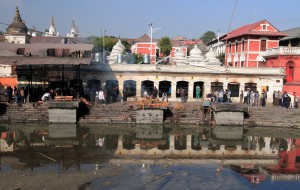
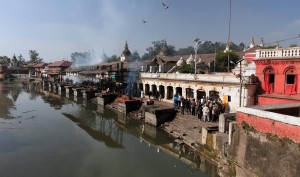
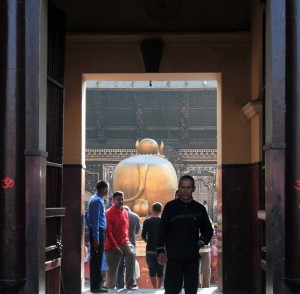
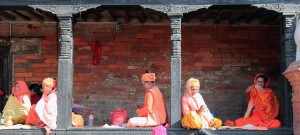
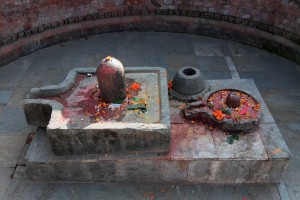
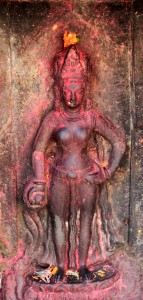
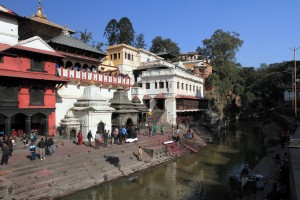
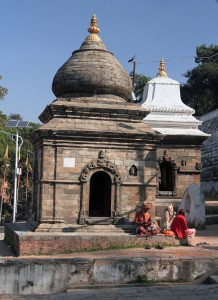
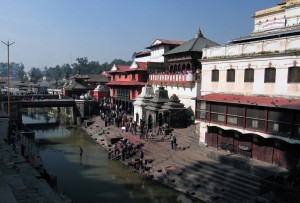
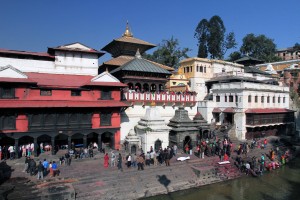
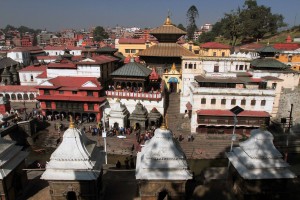
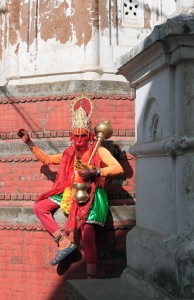
I walked northwesterly, past a golf course, and soon reached the Bagmati River. I then walked up to Pashupatinath Temple complex, paid the entrance fee that all foreigners have to pay (racist policy), and then walked along the river, watching Hindus cremate their loved ones. The temple serves as the seat of the national deity, Lord Pashupatinath, and was erected by King Bhupatindra Malla in the seventeenth-century; along the Bagmati River, which flows through the temple complex, many deceased Hindus are cremated and the ashes are dumped in to the river. The main temple in the complex, which has a giant gold-colored statue of a bull, is closed to all non-Hindus. I walked around the complex, across the Bagmati River to the western side, past many sādhus (supposed “holy men”) who paint themselves up for tourists to take pictures with them (for a price), to the front entrance to the main temple, Pashupatinath; I peered through the doors and saw the back of the giant bull sculpture; then I walked up several steps to view the temple from above (next to some monkeys) before heading back down and crossing the Bagmati River to the other side of the complex again. I then walked up some more steps to where there are many stupas, watched a very ill woman be carried down to the river on a stretcher so that she may touch its waters (next to two deceased bodies, covered in linen, waiting to be cremated), watched another deceased Hindu have several bereaved family members come up to him, one by one, before cremation (it was a very emotional scene and was surprised to see it displayed in such a popular tourist spot), and then walked around some more before heading on to my next destination.
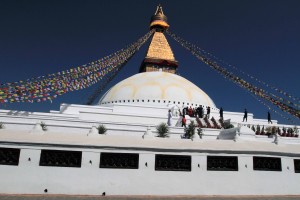
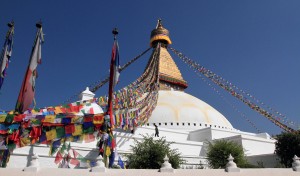
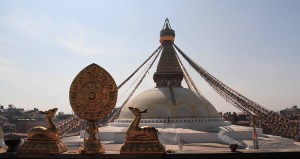

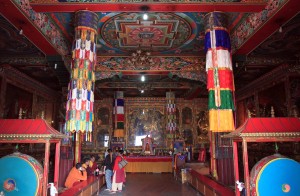
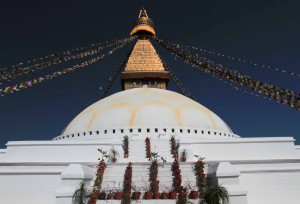
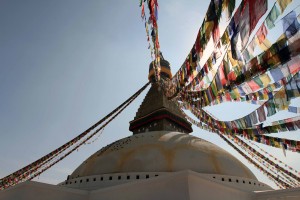
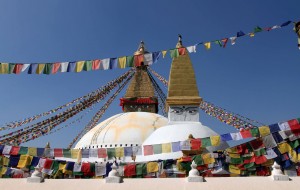
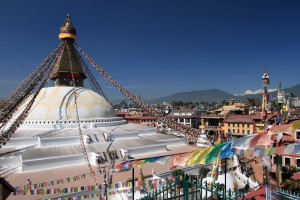
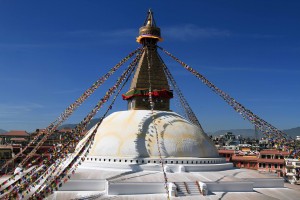
I exited the temple complex, walked along the Bagmati River a short distance, and then headed north through dusty winding streets with a lot of construction going on. I stopped at a pharmaceutical store along the way to buy sunscreen (I am white and I left my sunscreen back at the hostel, so I needed this to continue on for the day, to make it out alive), before continuing in a general direction toward Bouddhanath Stupa. I finally reached the stupa, paid the entrance fee, and walked around the stupa (clockwise of course!). According to legend, a widow named Ma Jhyazima wanted to make a great offering to Buddha and approached the local king for permission; he granted her permission on the condition that she used an area of land measuring the size of a single ox skin; however, Ma Jhyazima was a clever bitch, and she cut the skin in to thin strips and laid them end to end, covering an area of 120 feet in diameter, thus enabling her to build the giant Bouddhanath Stupa which stand today; the earliest recorded history of the stupa comes from the fifth-century AD. While walking around the stupa, I visited the Guru Lhakhang Monastery, which had some nice frescoes and sculptures. I then walked up one level of the stupa and circled it (clockwise of course!), taking many photographs of its Buddha eyes (a symbol of method and wisdom) and nose-like symbol (a symbol of Nirvana), the many prayer flags ascending from each corner to the lotus on top (just below the pinnacle and umbrella), and the large yellowish dome – it is a great monument worth visiting in Kathmandu. I then found a restaurant with a roof-top level, where I could admire the Bouddhanath Stupa in all its glory while eating lunch (I had dal bhat, Tibetan momos with Alu fingsha (the momos were just bread, meant to be dipped in the Alu fingsha – a soup/gravy-like concoction), and beer). After lunch, I continued to walk around the great stupa, before exiting the complex and taking a taxi back to Kathmandu – more specifically, Hanuman-dhoka Durbar Square (also known as “Kathmandu Durbar Square”).
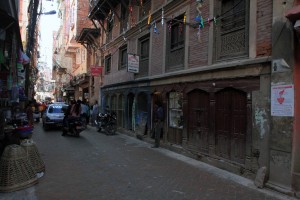
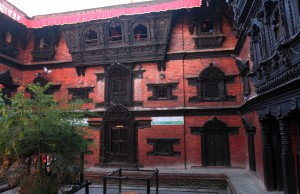
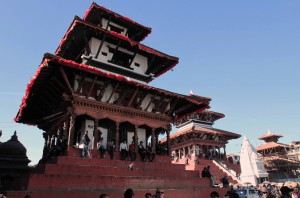
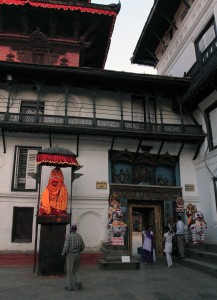
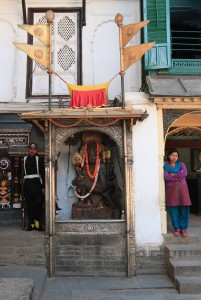
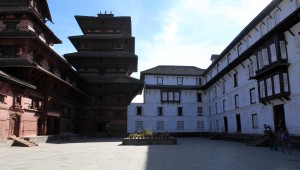
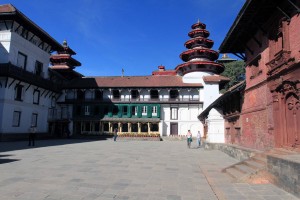
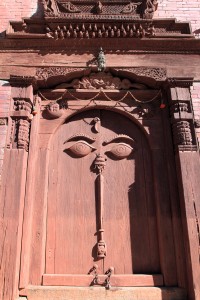
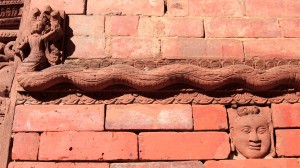
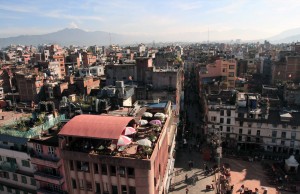
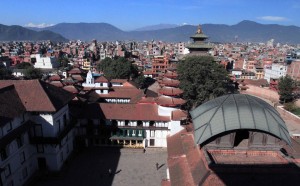
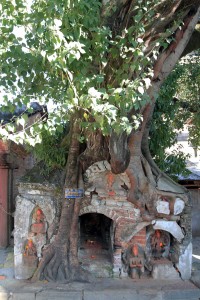
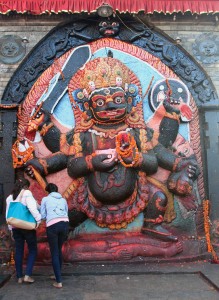
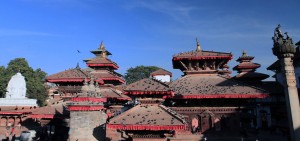
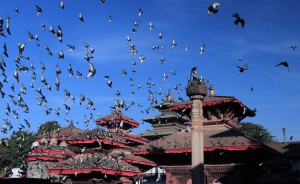
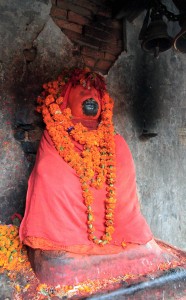
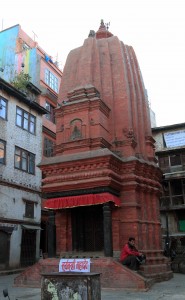
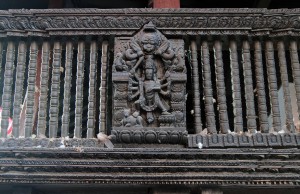
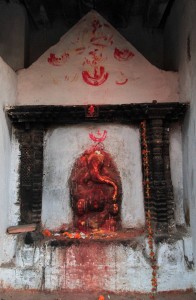
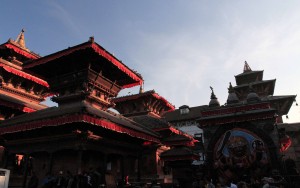
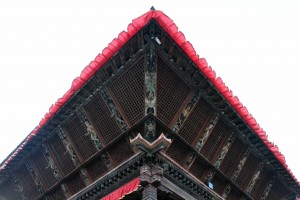
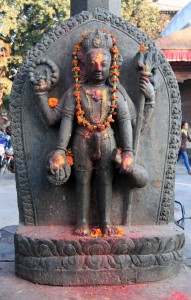
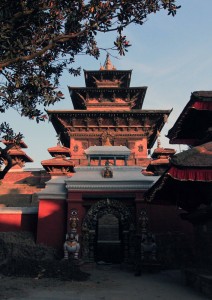
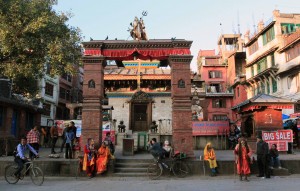
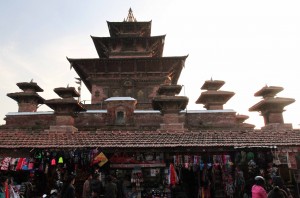
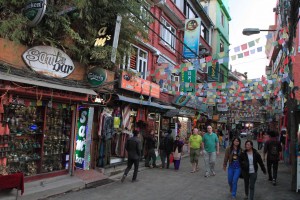
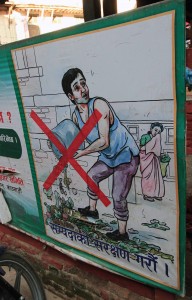
I reached Kathmandu Durbar Square, paid the taxi driver, paid the entrance fee, and then walked around the square for quite some time, taking in all the sights. The square was built between the twelfth and eighteenth centuries and has many old temples, shrines, pagodas, and a royal palace. I first visited Kumari-ghar (a beautiful building with an inner shrine for Hindus only (booo!)), then I walked past the large pagoda temples of Kasthamandap and Maju Dega, looking at the other temples and shrines in the vicinity, before continuing on to the Royal Palace. I entered the palace, next to the statue of Hanuman (the monkey god statue that gave this square its official name), and walked through Nasal Chowk (which has a raised platform that was used in coronation ceremonies for past monarchs), Mohan Chowk, Sundari Chowk, and Lohan Chowk (chowks are akin to courtyards in between the buildings). I walked up to the top of the Basantapur Durbar (a nine-storeyed tower built in 1770 AD and I also visited the museum galleries in the royal palace, which covered the reigns of Tribhuvan Bir Bikram Shah, Mahendra Bir Bikram Shah (who wore glasses similar to those worn by Phil Silvers), and Birendra Bir Bikram Shah. Each gallery had interesting artifacts and did a fine job of portraying each ruling monarch, but – to me anyway – the idea of kings and queens is so silly and outdated, I could not believe the adoration given to each shah, who took much of the public money to build large palaces and to serve their own selfish lives – what is wrong with people?; sure, we’re naturally attracted to the ruling class (usually better, stronger, wealthier individuals; it’s the whole follower mentality ingrained in each of us), but for a whole nation to support some family, who managed to make it out on top long ago, and its descendents is utterly silly (e.g. the house of Windsor); every nation should elect qualified individuals to rule the land (ideally, every nation should also be able to vote these individuals out of office when it becomes evident that they are useless pieces of shit causing more harm than good (e.g. Barack Obama)), not have some lineage of spoiled brats control all of the country’s affairs (e.g. Khalifa bin Zayed bin Sultan Al Nahyan and his sons) – obviously I hate these regal and well-to-do leeches that exist in today’s world. After visiting the royal palace, I walked around Kathmandu Durbar Square some more, seeing the huge stone relief of Kal Bhairav, which represents the deity Shiva in his destructive manifestation, many more pagodas, a shrine that has been nearly taken over by a tree, and a number of “holy men” hanging around to make money from tourists taking pictures of/with them. After satisfactorily having explored Kathmandu Durbar Square, I walked back to Thamel, and back to the hotel I was staying at. Instead of having a proper dinner, I had some beer and light snacks, before going to finally going to sleep sometime after dark.
